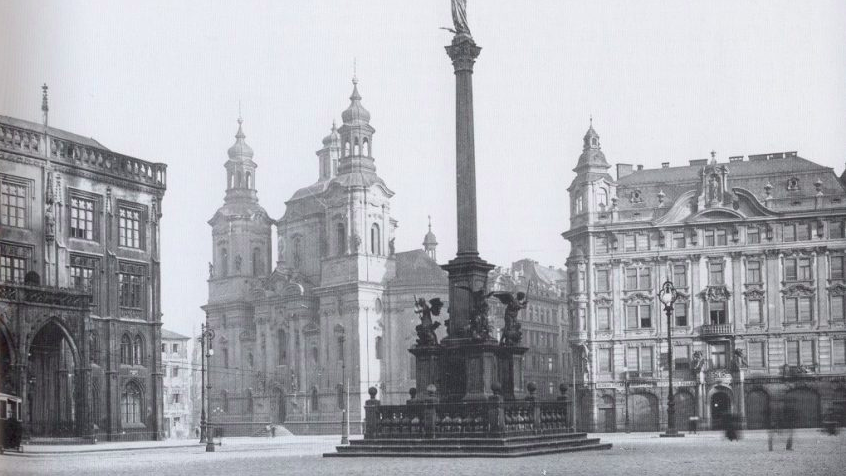The demolition of the Marian Column was one of the most iconic events of the newly proclaimed republic. The monument was seen as a symbol of the Habsburg Monarchy, and it paid the price. The column has opponents even today.
“Her head was violently severed from her body,” said Zizkov anarchist Franta Sauer, describing the demolition of the Marian column and the decapitation of the Virgin Mary. Sauer played a key role in the demolition of the column, which was surrounded by a large crowd on the first Sunday of the new era of the Republic.
The crowd of people marched into the centre of Prague from Bila Hora 101 years ago. It was a heated anti-clerical reminder of the fateful battle in November 1620. Sauer was assisted by the Zizkov firefighters, whom he had met in a pub in Zizkov. They supplied not only the manpower, but also the necessary ropes, chisels, and hammers.
There was a fight between the enthusiastic revolutionaries and the group of people who wanted to defend the baroque monument. The guardians of the column did not succeed, however. “Just take it down!” shouted socio-democratic politician Josef Stivín.
The revolutionaries wanted the fragments of the monument to be thrown from Charles Bridge into the Vltava, but this did not happen. Likewise, thankfully it was possible to prevent the destruction of the statues standing on Charles Bridge.
The debris of the monument instead ended up behind the gates of the municipal court at Prague’s town hall. The head of the Virgin Mary and fragments of the monument were later moved to the Lapidarium of the National Museum. After the act, the National Committee dissociated themselves from the demolition of the monument.
As the aftermath of the rebellion started to calm down, there were a few proposals to restore the monument. This did not happen in the era of the First Republic. After 1989, however, the situation began to look hopeful. A collection was created and the renovation of the monument was started in the studio of sculptor Petr Vána. There were also official hearings.

An unwanted monument
The story of the return of the sculpture and contradictory rumours spread like wildfire. The National Collection began 23 years ago, and in June 2017, supporters of the renovation received positive feedback from the construction department of Prague 1 town hall and intended to start working on it in the Autumn of that year.
Today, the sandstone replica of the Marian column is finished but remains with sculptor Petr Vána in his studio.
The construction of the memorial started in 1650 and it was festively consecrated by Prague´s Archbishop Cardinal von Harrach two years later. The Marian Column comes from the workshop of the most important Czech Early Baroque sculptor Jan Jiří Bendl and it is set by the statue of the Virgin Mary Immaculate.
The Marian Column was also very important for time determination because its shadow was showing the high noon during its fall over the Prague Meridian.

Proposals to re-erect a Baroque column with a Marian statue in Old Town Square has led to a religious controversy.
A group of Catholics and Prague history enthusiasts hope to erect in the city’s central Old Town Square a replica of the original column built in the 1650s and torn down in 1918.
Its height reached almost 14 m and on the top, there was a two meters high golden-plated statue of Virgin Mary, in the corners of the stone railings there were four groups of angels fighting with evil forces.
The column was viewed as a symbol of the Habsburg empire. It was erected to commemorated Prague’s defenders against the Protestant Swedish army at the end of the Thirty Years War of 1618-1648.
The Marian Column was also very important for time determination because its shadow was showing the high noon during its fall over the Prague Meridian.
In the past, similar plans to re-erect the column were stopped under both Nazi and Communist rule when many Czechs turned away from the Catholic Church.
In 1989 — shortly after the fall of Communism — local Catholics and history enthusiasts set up the “Association for the Renewal of the Marian Column.”
Archbishop Dominik Duka of Prague has spoken in favor of the project but has done so only privately “as a Catholic and a citizen.” The archdiocese has not taken an official position.
However, the association has found itself caught in a bureaucratic tangle. It possesses a building permit — scheduled to expire in July — but not permission for construction to begin at a specific site.
Hence, the association’s members have twice thwarted from digging up the square’s paving stones by municipal police.
The remains of the Marian Column are nowadays placed in the Lapidarium of the National Museum in Výstaviště.
Author: red

